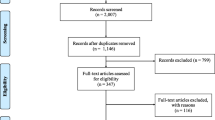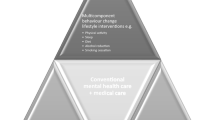Abstract
The objective of this paper was to determine predictors of complementary and alternative medicine (CAM) use among individuals with specific health problems. Data were derived from the 1998 Medical Expenditure Panel Survey (MEPS). After adjustment for potential confounders, individuals with perceived barriers to obatining care were more likely to use any CAM treatment (OR 2.16), herbal therapy (OR 2.70) and spiritual care (OR 3.99) for a specific health problem. Individuals dissatisfied with their family’s access to care were more likely to use acupuncture (OR 3.43). Dissatisfaction with quality of care was associated with increased use of spiritual therapy (OR 4.74). Perceptions of inadequate access to health care may contribute to utilization of CAM therapies; such therapies in this instance appear to be used as an alternative to mainstream medicine.
Similar content being viewed by others
References
National Center for Complementary and Alternative Medicine. What is complementary and alternative medicine (CAM)? Available at: http://nccam.nih.gov/health/whatiscam//1. Accessed on February 2, 2004.
White House Commission on Complementary and Alternative Medicine Policy. Final Report, March 2002. Available at: http://www.whccamp.hhs.gov/finalreport_pdf.html. Accessed on February 2, 2004.
Eisenberg, D. M., Davis, R. B., Ettner, S. L., Appel, S., Wilkey, S., Van Rompay, M., and Kessler, R.C., Trends in alternative medicine use in the United States: Results of a follow-up national survey. JAMA 280:1569–1575, 1998.
Landmark Healthcare, Inc. The Landmark Report of Public Perceptions of Alternative Care, Sacramento, CA, Landmark Healthcare, 1997.
Druss, B. G., and Rosenheck, R. A., Association between use of unconventional therapies and conventional medical services. JAMA 282:651–656, 1999.
Astin, J. A., Why patients use alternative medicine: Results of a national study. JAMA 279:1548–1553, 1998.
Furnham, A., and Smith, C., Choosing alternative medicine: A comparison of the beliefs of patients visiting a general practitioner and a homoeopath. Soc. Sci. Med. 26:685–689, 1988.
Murray, J., and Shepherd, S., Alternative or additional medicine? A new dilemma for the doctor. J. R. Coll. Gen. Pract. 38:511–514, 1988.
Krauss, H. H., Godfrey, C., Kirk, J., and Eisenberg, D. M., Alternative health care: Its use by individuals with physical disabilities. Arch. Phys. Med. Rehab. 79:1440–1447, 1998.
Sharma, R., Haas, M., and Stano, M., Patient attitudes, insurance, and other determinants of self-referral to medical and chiropractic physicians. Am. J. Public Health 93:2111–2117, 2003.
Featherstone, C., Godden, D., Selvaraj, S., Emslie, M., and Took-Zozaya, M., Characteristics associated with reported CAM use in patients attending six GP practices in the Tayside and Grampian regions of Scotland: A survey. Complement Ther. Med. 11:168–176, 2003.
Puf Data Files. December 2001. Agency for healthcare research and quality, Rockville, MD. Available at: http://www.meps.ahrq.gov/Puf/DataResultsData.asp. Accessed on February 2, 2004.
Cohen, S., An evaluation of alternative PC-based software packages developed for analysis of complex survey data. Am. Stat.. 51:285–292, 1997.
Skinner, C. J., Introduction to part A. In Skinner, C. J., Holt, D., and Smith, T. M. (eds.), Analysis of Complex Surveys, Wiley, New York, pp. 23–58, 1989.
Paramore, L. C., Use of alternative therapies: Estimates from the 1994 Robert Wood Johnson Foundation National Access to Care Survey. J. Pain Symptom Manage 13:83–89, 1997.
Andrulis, D. P., Access to care is the centerpiece in the elimination of socioeconomic disparities in health. Ann. Int. Med. 129:412–416, 1998.
Forrest, C. B., and Starfield, B., Entry into primary care and continuity: The effects of access. Am. J. Public Health 88:1330–1336, 1998.
Author information
Authors and Affiliations
Corresponding author
Rights and permissions
About this article
Cite this article
Ritchie, C.S., Gohmann, S.F. & McKinney, W.P. Does Use of CAM for Specific Health Problems Increase With Reduced Access to Care?. J Med Syst 29, 143–153 (2005). https://doi.org/10.1007/s10916-005-3002-x
Issue Date:
DOI: https://doi.org/10.1007/s10916-005-3002-x




